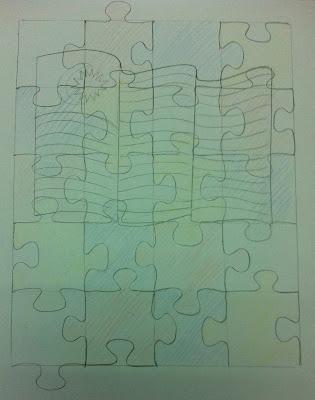In this sketch I want to emphasize the color use along with the puzzle piece. I felt that making the colors brighter would give it a childish look and so I left it as it is, to allow room for exploration (different shades).
I colored the pieces rather than the flag since I thought that it might make it look common and uninteresting. Furthermore, I wanted to emphasize the puzzles pieces rather than the image of the flag. Looking at this sketch I feel I could have played around more with the position of the flag and use different perspectives (close ups, a part of the flag).
This is similar to my previous sketch, in terms of using an image to create a puzzle piece. This time, I used a hibiscus to symbolize Malaysian culture. The colors used in this piece were inspired by the colors of the Malaysian flag.
The first four sketches involve my idea of using puzzles pieces to represent culture. Each piece connects together, as it symbolizes the connection between cultures. As I was doing research for my topic, I began to think of other ways to represent culture and it led me to fabric designs. I have a great interest in patterns and so I enjoyed creating these following sketches.
I took the same three type of patterns to represent the Malay, Chinese and Indian culture and played around with the composition. I used a typical batik design to represent Malay culture, peonies for Chinese culture and a repetitive mango shape for Indian culture. I particularly like the second and third sketch. The second sketch, because each pattern connect to one another, creating a cohesive composition.
Here, I played around with the symbol of the hibiscus by maintaining the color scheme of complimentary colors (adding white). The last two sketches incorporated the use of three main circular shapes. I decided to make the hibiscus only visible within the circles to create an interesting look. Additionally, the three circles represent the three cultures.
In this sketch, I attempted to explore the use of the circles but with different images. Instead of using a hibiscus I used the idea of lights to tie the cultures together.
I felt as though I strayed away from the topic of intercultural at help and so I came up with some ideas to incorporate the university/college setting with culture. Again, I am using hibiscuses and the concept of mixing the three cultures.
In these three sketches I wanted to bring together culture with the environment because essentially, the environment is a significant aspect of Malaysian culture. I wanted to place emphasis on the fact that Malaysia is known for their jungles.
In the first sketch, I used three specific animals that can be found in the Malaysian jungle and my idea was to use these animals as the three ethnic groups (Hornbill, Elephant and Tiger). To further create cohesion between the animals, I placed a hibiscus in each frame.
The second sketch emphasizes the use of color (within the droplet of water that is about to drop into the water). I intend on making the background black and white to create contrast between the colors or a light shade of green. In the third sketch I replace the jungle with the patterns I used earlier.














































